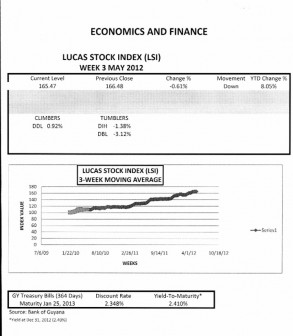Needed Focus
With the service sector accounting for two-thirds of the output of the economy, the behavior of major industries in that sector deserve some attention. The needed focus becomes even more critical when the industry is important not only to the sector, but also to the economy as a whole, as in the case of the construction industry. Where Guyana is concerned, it would be hard to ignore the impact of the construction industry on the country since it is the second largest component of the service sector, and a major driver of economic change in the economy. At 10 percent of the economy and 15 percent of the service sector, the industry has grown in importance over the years. It now generates output, twice that of the education industry, five times that of the health industry and about six times that of the electricity industry. It exhibited rapid growth in the last decade and has become an activity that many in the private sector pin their hopes on each year for business opportunities. The priority spending of the administration on infrastructure has helped to keep the industry buoyant and active. Yet, since the rebasing of the accounts using new measurement techniques, the construction industry has not shown the vibrancy and consistency in expansion as it did when its activities were accounted for under the old measurement system.

Unevenness in Growth
The query into the inconsistency of the industry is prompted by disclosures in the recent budget statements that cannot justifiably explain totally the uneven performance of the industry within the last five years. As its impact on the labour market suggests, the issue affecting the construction industry does not stem from lack of demand. To many, the unevenness in growth looks more like evidence of poor planning and the untimely execution of work, instead of a decline in big spending as the administration claims in its recent budget presentation. This claim is a frequent one of the administration even in years when it ends up spending more money than in previous fiscal periods. Guyanese ought to be concerned about this phenomenon. The collapse of spending in the construction sector was a big reason for the weakening of the US economy in 2007 and it remains a principal cause of the sluggish recovery today. That slow spending was engendered by the fall in demand for residential construction activity which later ensnared local governments and the commercial sector.
At the time of its dominance, as is the case in Guyana, construction was a substantial driver of the US economy and made up close to 10 percent of the output of the economy. A major difference between the two countries is that, at the height of the activity, a substantial portion of the investment in the construction industry in the US came from private investors. When the downturn hit, the private investors pulled back for fear of losing their money and left the industry in a state of uncertainty.
.
Minimal Impact
The administration accounts for in excess of 60 percent of the investment in the construction industry. In Guyana, demand for industrial construction involving the building of roads, sea defences, and other infrastructural works comes primarily from the government. The drive to see more Guyanese own their own homes also has seen government investment in the infrastructure for the building sites of the expected new domiciles. The government explained that the fall off in growth in 2011 was caused by several public sector investment projects coming to an end. For the many planned infrastructural works, the government intended to increase its expenditure in three of the last four years and actually did by an annual average of 13 percent. The budgeted expansion in spending was geared towards new activity and not old investments and undermines the claim that the lower growth was the result of a gap in production activity rather than some other cause. Increased spending ought to lead to increased output, especially in a year like 2011 where inflation was reported to be relatively low at 3.3 percent. Since price increases would have had minimal impact on purchases of factor inputs, the expanded spending should have reflected expanded output.
Horrid Time
Further, for the claim that many government projects came to an end to hold water, the projects would have had to have been completed very early in 2011. Through the tender process, private contractors participate in the construction industry. The many contractors relying on government projects would have had a horrid time in 2011 had the work from 2010 dried up as much as the administration contends, and as early as would be necessary to have a perceptible impact on the pace of growth. The risk of that happening in an election year was too great, and with very little activity to fill the void in 2011, contractors would have made a great deal of noise that could have easily frightened the administration of the day into thinking and behaving differently. The data show that government spending did not slow in 2011. It grew by as much as 10 percent on the spending disclosed for the previous year. The irony about that is, in 2010, spending actually declined by two percent, and in that very year output grew by 11 percent. While this could be the result of a timing issue, the general trend and size of spending cast doubts over whether or not the effects of the projects executed in 2010 were expected to be carried over into 2011. The 2011 budget does not suggest that occurrence.
Untimely Execution
More access to pertinent data was likely to provide evidence that the untimely execution of work might be a more realistic explanation for the unevenness in growth. For now, one has to rely on the pattern of declared spending by the government to look for answers. In three of the last four years where spending grew from one year to the next, growth in output was below projected levels. Whenever growth declines, despite the increase in spending, and inflation is not a contributing factor, it is indicative that planned activities were not executed in a timely manner. The higher level of spending could have come from cost overruns prompted by premium payments designed to induce a faster execution of work. Cost overruns are always associated with late or incomplete work as in the case of the Amaila Falls road project makes clear. When output does not catch up, it means that either the level of activity was way behind schedule or there were too many impediments in the system that frustrated and consumed the additional spending. This latter scenario is a more realistic outcome because the impediments in the government bureaucracy affect both public and private investment in the industry, and thus have a broader impact on performance.
Deliver
In light of the foregoing observations, the uneven performance of the construction industry could be the result of poor planning and poor project execution. The reasons for this type of performance might be linked to bottlenecks in the administrative system and limited availability of required technical skills to get the job done in a timely manner. Unless these constraints are removed, the industry will not be able to deliver the type of output on a consistent basis that Guyanese should expect from the level of spending that takes place.








